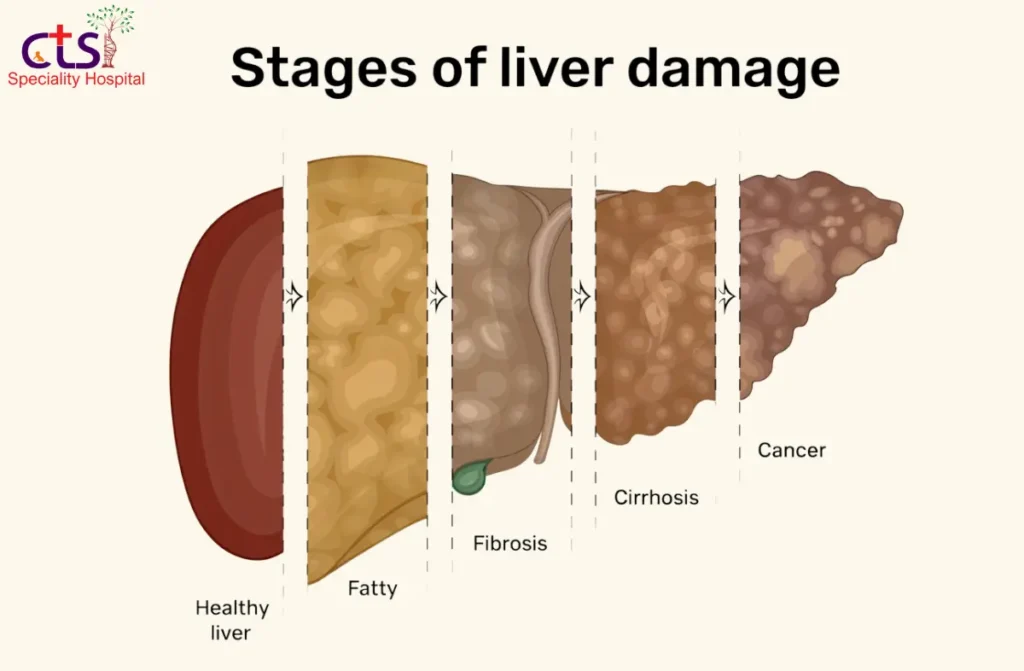Your liver doesn’t raise red flags with loud alarms — it whispers. And if you’re not listening, those whispers can turn into irreversible damage. The signs of liver damage often creep in quietly, masked as fatigue, a little bloating, or a loss of appetite you chalk up to stress. But here’s the truth — your liver is one of the hardest-working organs, and when it starts to give out, it rarely gets a second chance. Whether you’re someone who enjoys a few too many drinks, lives with diabetes, or has a family history of liver issues, it’s time to stop ignoring the signs. Because liver damage isn’t sudden. It builds — silently, dangerously.
What is Liver Damage?
- Keep an eye on darker-than-usual urine or pale stool, especially when paired with other symptoms. These color changes reflect bile flow issues, which often point directly to liver dysfunction.
- Liver damage refers to the gradual breakdown or scarring of liver tissue caused by repeated injury or inflammation. Over time, this can interfere with the liver’s ability to perform essential functions like detoxifying the blood, regulating metabolism, and producing proteins critical for clotting and digestion.
- One of the early symptoms of liver damage is persistent fatigue, even after a full night’s sleep. This occurs because a struggling liver can no longer efficiently clear toxins, leaving the body feeling sluggish and drained.
- Another subtle sign is unexplained digestive discomfort — think bloating, nausea, or reduced appetite. When the liver falters, bile production gets disrupted, leading to issues in breaking down fats and absorbing nutrients properly.
- Changes in skin tone, such as yellowing (jaundice) or an unusual itchiness without rash, are clear signs of liver damage. These symptoms arise from the buildup of bilirubin and bile acids in the body, both of which the liver normally handles.
- Easy bruising or bleeding could signal that your liver isn’t producing enough clotting proteins. This often flies under the radar until someone notices frequent nosebleeds or unexplained bruises.
- Swelling in the legs, feet, or abdomen (ascites) may appear as the liver loses its ability to regulate fluids and blood pressure within the body. This is typically a sign that damage has progressed beyond the early stages.
Mental fog, confusion, or memory lapses — often mistaken for aging — can be signs of liver damage. A compromised liver fails to filter out toxins like ammonia, which may impair brain function and lead to cognitive issues. Recognizing these symptoms early is key to protecting your liver and overall health.

14 Signs of Liver Damage You Should Never Ignore
- Yellowing of the Skin and Eyes (Jaundice): A classic red flag, jaundice is caused by a buildup of bilirubin — a yellow pigment normally processed by the liver. When the liver fails to eliminate it efficiently, it spills into the bloodstream, turning the skin and whites of the eyes yellow. This symptom is often one of the early signs of liver infection or damage caused by conditions like hepatitis or blocked bile ducts.
- Unexplained Fatigue: Constant tiredness that doesn’t improve with rest can signal liver dysfunction. A damaged liver can’t effectively clear toxins, which begin to circulate and affect energy levels. It’s also common in alcoholic liver disease early symptoms as the liver becomes less efficient.
- Abdominal Pain and Swelling: Discomfort or pain in the upper right abdomen — where your liver lives — could indicate inflammation or enlargement. In severe cases, fluid builds up in the belly (ascites), making the abdomen visibly swollen and tight.
- Dark Urine and Pale Stool: Dark-colored urine may result from excess bilirubin, while pale or clay-colored stool reflects a lack of bile flow. These are often early signs of liver damage from medication or bile duct obstruction.
- Nausea and Vomiting: As the liver loses its ability to detoxify, nausea becomes more frequent, especially after meals. Persistent vomiting is not just a stomach issue; it can point to progressive liver damage.
- Loss of Appetite: A subtle but critical symptom, reduced hunger may arise due to systemic inflammation or bile production issues. Over time, this leads to weight loss and nutritional deficiencies — all signs of advanced liver dysfunction.
- Swollen Legs and Ankles: Poor protein synthesis and fluid regulation by a damaged liver often result in edema — fluid buildup in the lower limbs. This is commonly seen in cirrhosis and signals late-stage liver stress.
- Itchy Skin: Persistent itchiness, especially without a rash, can stem from bile salt accumulation under the skin. It often worsens at night and is one of the lesser-known early signs of liver infection or obstruction.
- Easy Bruising or Bleeding: The liver produces clotting factors. When it’s impaired, even minor bumps can cause noticeable bruising, and gums or nose may bleed more easily — a quiet but serious alarm bell.
- Confusion or Difficulty Thinking (Hepatic Encephalopathy): When toxins like ammonia aren’t filtered out by the liver, they reach the brain, causing memory loss, mental fog, or mood swings. This symptom typically appears in advanced stages but may creep in during early liver dysfunction.
- Chronic Itchy Skin: Unlike occasional itchiness, chronic scratching that disturbs sleep or daily life could signal long-term liver trouble. This is often linked to cholestasis — a condition where bile flow slows or stops.
- Persistent Fever: Low-grade fevers that keep coming back may indicate chronic liver inflammation or infection. It can be particularly relevant in viral hepatitis cases or alcoholic liver disease early symptoms.
- Changes in Skin Color or Texture: In some cases, liver damage can make the skin appear blotchy, reddish on the palms, or spider-like blood vessels may appear. These changes suggest deeper hormonal imbalances caused by liver dysfunction.
- Weight Loss: Rapid or unexplained weight loss can occur as appetite declines and the body struggles to absorb nutrients. It’s a serious sign, especially when paired with fatigue and gastrointestinal issues, and often surfaces in both viral and alcohol-induced liver disease cases.
What Causes Liver Damage?
- Excessive Alcohol Consumption: Chronic drinking overwhelms the liver’s detox pathways, causing inflammation, fatty liver, and eventually cirrhosis. Early signs of liver damage include persistent fatigue, loss of appetite, nausea, and dull pain in the upper right abdomen. Recognizing these symptoms early can help prevent severe liver complications.
- NAFLD: Fat buildup due to obesity or diabetes can silently progress to liver scarring and bloating.
- Hepatitis B & C: These viral infections trigger chronic inflammation, with early symptoms like fever, joint pain, or jaundice.
- Medications: Overuse of drugs like paracetamol can spike liver enzymes silently.
- Autoimmune Hepatitis: Immune attack on liver cells leads to fatigue and jaundice.
- Genetic Disorders: Conditions like hemochromatosis disrupt liver function early.
- Environmental Toxins: Chemical exposure can irritate and inflame the liver.
- Diabetes & Cholesterol: Both contribute to silent fat accumulation in the liver.
- Cholestasis: Bile duct blockage causes pale stools, itching, and dark urine.
How Liver Damage is Diagnosed
- Medical History & Physical Exam: Doctors assess alcohol use, medication history, and family conditions. Physical signs like jaundice or abdominal swelling may reveal early liver issues.
- Liver Function Tests (LFTs): Blood tests check enzyme and bilirubin levels to detect inflammation or bile flow problems before symptoms appear.
- Imaging (Ultrasound, CT, MRI): These help identify fat buildup, tumors, fibrosis, or bile duct blockages.
- FibroScan: Measures liver stiffness non-invasively, useful for tracking chronic conditions.
- Liver Biopsy: Confirms inflammation, fat, or scarring when other tests are unclear.
- Genetic/Serologic Tests: Detect hepatitis or inherited liver diseases.
- Ammonia Test: Evaluates confusion due to liver-related brain toxicity.
How to Prevent Liver Damage
- Limit Alcohol: Avoid excessive drinking to prevent inflammation, fatty liver, and cirrhosis.
- Maintain Healthy Weight: Exercise and eat nutrient-rich foods to reduce fat buildup and NAFLD risk.
- Use Medications Wisely: Avoid overuse of painkillers like acetaminophen; monitor for nausea or fatigue.
- Get Vaccinated: Protect against hepatitis A and B to reduce long-term liver inflammation.
- Avoid Toxins: Use protective gear around chemicals; minimize exposure to industrial solvents.
- Manage Health Conditions: Control diabetes and cholesterol to avoid liver strain.
- Stay Hydrated & Eat Well: Consume antioxidant-rich foods like greens and berries.
- Watch for Symptoms: Recognize early signs like fatigue, dark urine, or yellowing eyes.
Can Liver Damage Be Reversed?
- Depends on Stage: Early liver damage can often heal if the root cause is removed. Advanced stages like cirrhosis are usually irreversible.
- Lifestyle Changes Help: Quitting alcohol, losing weight, and eating well can reverse fatty liver and reduce inflammation.
- Hepatitis Treatment: Antiviral meds for hepatitis B or C can slow or stop damage if started early.
- Drug-Induced Damage: Stopping harmful medications can restore liver health if caught quickly.
- Autoimmune Hepatitis: Controlled with immunosuppressants, allowing the liver to recover.
- Cirrhosis Is Permanent: Damage can’t reverse, but further harm may be prevented.
- Act Early: Recognize symptoms like jaundice or fatigue before it’s too late.
Conclusion
Recognizing the signs of liver damage early can be life-changing — and often, life-saving. The liver works silently until it’s overwhelmed, and by then, the damage may already be deep. From subtle fatigue and digestive shifts to yellowing skin and cognitive changes, every signal your body sends matters. Taking control through awareness, healthy choices, and timely checkups can stop damage in its tracks. Your liver doesn’t ask for much — just that you don’t ignore its quiet cries.
